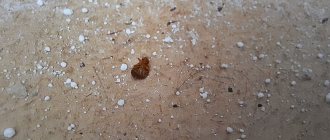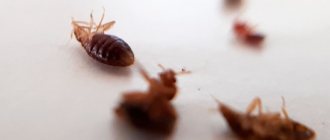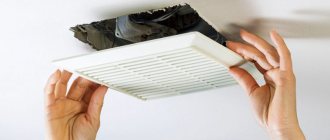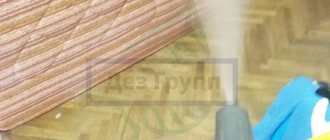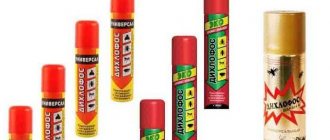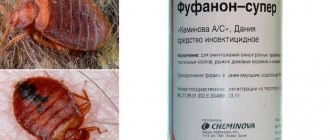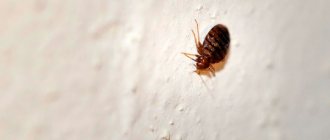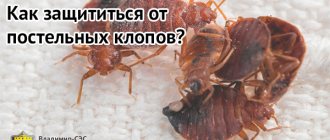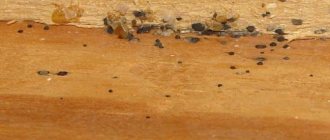Sometimes you can hear people complaining that professional treatment of an apartment for bedbugs did not bring one hundred percent results, and after a while the parasites returned again. This is most often due to non-compliance with exterminators’ recommendations for cleaning the premises after the procedure.
In this case, some single insects survive, and the problem again becomes relevant. To prevent parasites from reproducing, you need to understand what needs to be done after treating an apartment for bedbugs and when cleaning should be done.
What is pest control?
Disinsection is the professional treatment of premises using toxic agents that have a destructive contact and intestinal effect on parasites. In residential areas it is carried out using hot or cold fog. This allows you to destroy bedbugs in hard-to-reach places, as well as in furniture and clothing.
In the first case, a working fluid is poured into a special reservoir, which, when the compressor is turned on, is injected into the air under pressure and becomes finely dispersed. The settling of cold fog particles on the surface of the treated room occurs within 3-4 hours.
In the second case, after turning on the compressor and under the influence of the heating element, the working fluid is injected into the air in the form of steam, the particles of which settle on the surface within 8-10 hours.
Pest control
Vitality of parasites
Domestic bloodsuckers are endowed with increased adaptability to negative external factors, which is why their destruction is so problematic. It is impossible for insects to disappear without outside intervention. A number of factors from the life of parasites:
- They move freely around a living space and look for a victim anywhere.
- They feed on human blood, but in the absence of a source they do not die, but fall into suspended animation (comatose state). They can remain in this form for up to a year or longer. Smelling fresh blood, they wake up and function with no less vivacity.
- Exposure to low temperatures puts you to sleep.
- They reproduce intensively. In one go, the female lays up to 30 eggs, and in a lifetime - about 500. The development of the embryo lasts only 4 days, then the larva hatches and a month later an adult insect is formed.
- Even after professional disinfestation of a residential property, the eggs remain untouched for another 2-3 weeks.
Having analyzed such qualities of insects, it is clear why they do not die immediately after the first sanitation. Repeated is necessary to destroy nymphs emerging from egg clutches.
Airing the apartment
After the waiting period after disinfestation, all rooms must be thoroughly ventilated. You need to create a draft by opening windows and doors wide. To ensure safety in the treated room, it is necessary that the insecticide completely evaporates and its layer on the surfaces dries.
Attention! After disinfestation, the apartment should be ventilated for 2-3 hours. You cannot be in the room at this time to prevent poisoning.
Therefore, it is recommended to go outside and wait. After ventilation is completed, you can stay in the apartment after disinfestation without fear for your health.
Contact a reliable service
Not only professionals work in the sanitation services market. Unfortunately, there are plenty of hacks and amateurs. If the apartment continues to be attacked by bedbugs after disinfestation, it is possible:
- Employees of the company that took over the processing saved the drug or diluted it incorrectly.
- Inaccurate calculations of the area of the room were made (the intensity of the impact depends on this).
- Disinfectors left certain areas of the apartment untreated.
It is important to know: repeated treatment against bedbugs is possible no earlier than after 3 weeks. Contacting the SES “Pest Control Service” is a guarantee of a professional approach and effective results.
Cleaning the apartment after bedbug poisoning
After disinfestation and ventilation of the rooms, minimal cleaning can be done. In this case, it is necessary to leave as many surfaces as possible on which there will be a dry layer of insecticide. The remaining parasites, while moving around the house, will come into contact with a toxic substance, which will lead to their death.
Cleaning
After disinfestation, it is recommended to wipe only:
- kitchen tables;
- taps;
- toilet;
- shells;
- surfaces of bedside tables;
- handles on doors and cabinets.
To neutralize the toxic effect of the insecticide, work surfaces must be washed with a soapy solution with the addition of soda. After this, wipe with a cloth soaked in plain water.
Attention! You can wash floors after disinfestation only in the room where children and pets usually play. But during the initial cleaning process, you should not wash off the insecticide from the baseboards, and you should also leave the areas under the beds and cabinets untouched.
After disinsection of the apartment, no stains remain on the furniture or floor from these blood-sucking parasites. Therefore, there is no urgent need for thorough cleaning.
What should you do with clothes and things in closets?
In our experience, there are almost never bedbugs in closets with clothes. Over 15 years of work, out of six exterminators, only one saw bedbugs in such cabinets, and that happened in catastrophically infested apartments. For this reason, wardrobes are treated with insecticide only from the outside, with the doors closed, and the drug does not get on the clothes themselves. Therefore, there is no need to do anything with it after sanitation.
If some items were hanging openly in the room and the product could get on them, then they will need to be washed and then safely worn further. When washing, all the insecticide is washed off from the clothes and when put on, the body will not come into contact with the product.
Is it possible to sleep on treated sofas and beds?
You can sleep on all beds and sofas after they have been disinfested for bedbugs. This is also necessary in order to provoke the surviving parasites to get out of their secluded shelter in search of a food source. As a result, they come into contact with the insecticide that remains on the surfaces after disinfestation.
If there are concerns that a toxic substance while sleeping on a treated sofa or bed may harm your health, you should cover the sleeping area with not one sheet, but two or three. You can also put several pillowcases on the pillows.
On a note! If, after disinfestation, a person does not sleep in the apartment, then the likelihood of destruction of the remaining surviving individuals is reduced. And this may cause them to reproduce again after some time.
Rules for performing reprocessing
Repeated sanitation is necessary in the following scenario:
- the areas where bloodsuckers accumulate have changed;
- after a month and a half, the number of bedbugs has not decreased;
- the remaining insects multiplied again or fled from their neighbors.
The reason for the ineffectiveness of the previous disinfestation could be premature general cleaning or new bloodsuckers were brought into the house and they multiplied intensively. The service operator is informed of the possible cause, and he will suggest a solution to the current problem.
When calling a warranty technician, the same manipulations are performed:
- Assess the situation, as the location of the bedbugs may have changed.
- Surfaces and places where new pests are located are treated with a chemical preparation.
Since bedbugs quickly develop immunity to insecticides, it is recommended to use a different drug next time. The optimal duration of the event is 12-14 days after the initial procedure. But not later than a month, otherwise the hatched young insects will breed in no less quantity and lay new clutches.
What to do if there is still a strong smell after cleaning?
A persistent specific odor that persists after disinfestation indicates the use of a cheap drug for baiting bedbugs. Even wet cleaning done several times does not help get rid of it. In this case, the problem can only be eliminated by deodorizing the room.
This procedure involves treating the apartment with a dry fog, which neutralizes insecticide molecules on all surfaces. It helps get rid of an unpleasant odor, but the cost of such a service is equivalent to disinfestation against parasites.
Attention! To avoid having to deodorize your apartment later, you should immediately refuse the services of disinfectants with a dubious reputation and suspiciously low prices.
Room deodorization
When is it necessary to thoroughly clean the premises?
It is necessary to completely clean the room after baiting bedbugs after 5-6 days, if during this time neither live parasites nor their bites on people were found.
If there are live bugs in an apartment, or from time to time people discover bites on themselves, you need to find out what kind of parasites they are - survivors of persecution, or those that entered the room from neighbors. Depending on this, subsequent actions need to be taken. We talked about this in detail when we looked into how quickly bedbugs die after treatment...
If there are no bedbugs left in the apartment, then 5 days is enough to make sure of this. After this, you can do a complete wet cleaning:
- Vacuum all floors, baseboards and carpets (including those that were rolled up before disinfestation);
- Wash the floors in all rooms;
- Wash baseboards, window sills, lower surfaces of window sills;
- Wipe the back and side walls of furniture (including cabinets and bookshelves) with a damp cloth;
- Remove mattresses from beds, wipe the frame and frame with a damp cloth, and wipe the inside surfaces of linen drawers in sofas;
- Wipe the door frames with a damp cloth;
- Vacuum carpets hanging on the walls.
In general, this should be a full-fledged general cleaning, during which all surfaces sprayed during treatment will be washed.
After such cleaning, you can be sure that there are no bedbugs or insecticide in the apartment
There is no need to wash upholstered furniture with anything special after treatment. It is enough to vacuum it several times during regular cleaning. After this, there will be no dry insecticide left on its surface.
What if there are signs of poisoning?
After baiting bedbugs, signs of poisoning may appear only if safety rules are not followed. This can happen if a person entered the room without a respirator during the treatment, or the apartment was not well ventilated after treatment.
Symptoms of poisoning:
- increased salivation;
- tearfulness;
- runny nose;
- unpleasant taste in the mouth;
- sore throat;
- dizziness;
- nausea.
If alarming signs appear, you need to go out into the fresh air and breathe. It is recommended to take absorbents if the insecticide gets into the digestive tract, otherwise there is no need for it.
What should you do immediately upon returning?
First of all, after returning to the apartment, you need to:
- Ventilate all rooms with a cross-flow of air. Simply put, organize a draft so that all rooms are ventilated. You need to ventilate the room for at least half an hour, preferably an hour and a half.
- If clusters of dead or dying bedbugs are found somewhere, then collect them with a broom and flush them down the toilet.
After baiting bedbugs with certain preparations (mostly domestically produced), a characteristic chemical odor may remain in the room, which only weakens, but does not disappear after ventilation. There is no need to be afraid of it - the smell itself is not dangerous and cannot lead to poisoning; it is emitted by a dry preparation on walls, floors and furniture. From those domestic poisons that our specialists work with, this smell disappears in 2-3 days, including from soft furniture elements. This means that you should not try to get rid of this smell immediately, during the first airing.
Therefore, by the way, although imported drugs are a little more expensive (and their treatment is a little more expensive), they are also preferable, since after treatment with them there is no smell left at all and you can be quite comfortable in the apartment immediately after returning.
Hot fog treatment
At first - half an hour to an hour - during ventilation there should be only one person in the room wearing a respirator, or at least a cotton-gauze bandage. If there is no respirator, then you need to enter the room, open all the windows, remove the bags from the ventilation grilles (the disinfectant secures them here before etching), leave the front door open and leave. For the next half hour or hour, you can stay near the front door, but outside the room. After this, all people can enter the apartment and begin cleaning it. Children and pets can only be brought into the premises after cleaning.
Initial actions
In cases where the number of bedbugs is large enough, it is not always possible to remove them using chemicals. To solve the problem, it is better to resort to professional disinfection. However, to make cleaning the room after treatment easier, you need to perform some steps before starting the procedure:
- Remove all food and personal hygiene items from the premises. This precaution is due to the fact that splashes of chemical solutions can get on them, and then everything will have to be thrown away.
- Provide free access to the sleeping area, as it is processed first.
The processing process itself will take a little time - about 1 hour. To avoid the effects of chemicals on the human body, you need to know what to do after treating the apartment. After disinfection, owners must leave their home for at least 2 hours. Upon returning home, you need to immediately open all the windows so that the apartment is properly ventilated. This will take 3 to 4 hours. Entering a room where chemicals have been treated is not very dangerous, but there will be a specific smell that must be gotten rid of. It is recommended to wash floors no earlier than every 3 days.
Then you should scoop up dead bedbugs, their eggs and larvae, pour them into a garbage bag, which you should immediately take to the trash can or burn. You can also collect insects using a vacuum cleaner. You can only collect with your hands while wearing rubber gloves, which must be thrown away after that.
Wet cleaning should be done as late as possible. Therefore, it is recommended to go somewhere - to relatives, friends or to the country. This is due to the fact that live insects may remain in the room, hiding in secluded places. If you do not do wet cleaning, then they will also die after some time, moving on the treated surfaces. I should return to the apartment in 2 weeks.
Too many bedbugs?
In rare cases, the concentration of bedbugs in a room may exceed reasonable limits, and then treatment alone will not help. As a rule, pest control services warn in advance about the need for re-treatment, based on their experience. If you decide to destroy bedbugs yourself, be prepared for the fact that if there are too many insects, you will have to carry out the procedure again in 3-4 weeks. At the same time, it is strictly recommended to change the composition of the drug, as after the first treatment the bedbugs will develop immunity to the poison. And be sure to use only professional pest control products: using an inexpensive aerosol will provide you with the fight against bedbugs for years to come.
How is repeated disinfestation performed?
Repeated treatment by a specialist begins with an inspection and analysis of the premises: by this time the bedbugs may change their location. After examining the environment, the specialist sprays the chemical, paying special attention to hard-to-reach areas.
During disinfestation, another insecticide may be used, more powerful than in the first treatment.
Check your neighbors
If you have poisoned bedbugs, but the insects have not disappeared, it makes sense to contact your neighbors. It is quite possible that pest outbreaks are located in their area. In search of a new home, bedbugs can migrate from neighbors to you through ventilation, cracks in the floor and baseboards. In this case, treating one apartment will not solve the problem; after some time, the insects will return and annoy you with bites. It makes sense to cooperate with your neighbors and carry out professional extermination of bedbugs in several houses at once. For prevention, you can also close the ventilation with a fine mesh and seal the cracks in the baseboards. From now on, this will protect you from neighboring insects, be it bedbugs, cockroaches, flies or others.
We had an order from a client and there were bedbugs in the bed. When we arrived, it turned out that we had already been poisoned a month ago, but the bedbugs had not disappeared. We checked the whole apartment again, it turned out that the ventilation was poorly sealed, we went to the neighbors, they also had a problem with bedbugs. The neighbors poisoned them themselves the old fashioned way, with a spray; the insects had already developed immunity to dichlorvos; as soon as they started poisoning them, they crawled through the ventilation to our client. In the end, we agreed, our service poisoned 3 apartments on the floor, after that the parasites seemed to disappear, no angry calls were received
Valentin, Anti-Bed Master. Saint Petersburg
When is disinfection and disinsection used in homes?
The disinfection procedure is necessary in several cases. Despite the smell, it should be used:
- After visiting the premises by a sick person. Acute infectious diseases are easily transmitted by airborne droplets, which makes them very dangerous. It is worth taking care of your health and getting rid of microorganisms that have entered your home, protecting the health of yourself and your loved ones.
- After a long illness of one of the family members. It is worth protecting yourself from re-infection and carrying out a number of disinfection procedures.
The presence of disease carriers in the house also leads to infection with various diseases. Cockroaches, bedbugs, and ants settle indoors and move over all surfaces, bite the skin, and bring with them pathogens of all kinds of diseases. To get rid of them, disinfestation is carried out, which should cover the house and personal vehicles, because insects can also be in cars.
These procedures are carried out using strong-smelling insecticides, necessitating the need to remove odors using the most effective means. Opening windows and doors and ventilating with a hard-working climate control system do not provide adequate salvation.
Features of kitchen cleaning
The kitchen and dining room are disinfected especially thoroughly. These rooms contain the largest number of adult insects, which migrate to other rooms. Before processing, be sure to remove all food products, including unopened ones (packages of cereals, sugar, salt, flour).
To avoid poisoning, cleaning the kitchen after disinfestation of cockroaches is carried out not only superficially. Wipe the interior walls, shelves of cabinets, and bedside tables with soapy water. Wash the handles of the refrigerator, microwave oven, and the inner chamber of the oven.
What not to touch:
- the upper part of the refrigerator body, wall cabinets;
- tiled walls;
- window frame, cornices;
- hood, gas boiler, boiler;
- sockets, cables for household appliances;
- water supply units (wiring, pipes, sewerage);
- trash can (bucket);
- baseboards, radiator, door frame, lighting fixtures.
Wash all dishes thoroughly under the tap or in the dishwasher. Products can be collected upon completion of cleaning. If food is accidentally left in the cabinets, it is not suitable for consumption. Such products should be placed in a plastic bag, tightly closed (tie) and thrown into the trash.
Cleaning after disinfestation – reviews from our clients:
Lyudmila, salesman, 35 years old
I expected that after baiting the cockroaches I would spend the whole day cleaning. It turned out that you just need to call the professionals of the cleaning company Premium Eco Cleaning, and the service specialists will come and competently carry out the cleaning.
Oleg, cadet, 23 years old
There were bedbugs in the dorm room. The cleaning was carried out by specialists from the cleaning company Premium Eco Cleaning. The whole event took no more than 3 hours, the craftsmen cleaned everything up. There was no trace or smell left.
Svetlana, housewife, 38 years old
Before cleaning the rooms, I removed everything unnecessary, so the cleaning by the cleaning company’s specialists took only 3 hours. The chemical smell disappeared immediately after cleaning. I am very pleased with the work of the SES service and the cleaning by the cleaning company.
Prevention of re-infection
You can avoid re-infection of the premises if you take preventive measures:
- Seal all the cracks through which bedbugs can enter the apartment. Seal the ventilation shaft with mosquito netting. Do not open windows and balcony doors without a mosquito protection frame. Check the tightness of the seal on the entrance doors.
- Constantly use barrier protection against bedbugs entering your home.
- After trips, when you had to stay in hotels, hostels or private apartments, immediately wash all items at high temperature.
- Periodically steam your pet's bed if he is outdoors.
These simple measures will help save nerves and effort, which can be used to get rid of insects.
In what cases is repetition necessary?
Sometimes people continue to see bedbugs even though they have died long ago.
If bedbugs appear again after disinfestation, repeated chemical treatment will be required. It is necessary in the following cases:
- The bugs continue to bite, they were not killed the first time;
- The habitat changed, but the insects did not go far: for example, they moved from the bedroom to the nursery;
- Not all insects died the first time. This may be due to failure to follow the recommendations of the exterminators, poor preparation before the procedure (for example, the specialist was unable to get to the corner where the surviving individuals had accumulated), too much contamination of the room, quickly cleaned the home (the poison did not have time to take effect);
- The apartment was re-infected - new individuals entered the apartment;
- Often there is a psychological factor: the bedbugs have disappeared, but residents think that they remain and continue to bite. This creates the illusion that the pests have not been completely destroyed.
Bedbugs are extremely tenacious parasites that easily adapt to the action of chemical poison. If after disinfestation there are still live bugs, you will have to call sanitation specialists again. At the same time, they must treat the room with another poison, to which the insects do not yet have immunity.
Repellent odors for cockroaches
The odors that these ancient parasites cannot stand are chemical and natural. The use of the former is very difficult due to the fact that these substances are unpleasant to the human sense of smell. The conversation about them will come second. But the use of various natural aromas can perform both useful and pleasant functions. For example, you can put a sprig of red or black elderberry in a vase and place it on the kitchen table. The same goes for tansy and chamomile (pyrethrum) flowers. Such a decorative detail will help scare away unwanted guests, because the aroma of these plants is very unpleasant for cockroaches.
Another great way to combine functions is to use an aroma lamp. Many essential oils are repellent to cockroaches. It is recommended to use in aroma lamps or spray indoors with a spray bottle a solution of oils from the following plants:
- eucalyptus;
- sagebrush;
- mint;
- anise;
- honeysuckle;
- tea tree;
- cedar;
- lavender.
All these plants have a specific, but pleasant aroma for humans. Of course, if you are allergic to any of the listed plants, you do not need to use its extract. In other cases, this is a safe and comfortable way to scare away six-legged pests from your home.
Tamara 47 years old
From my own experience, I can recommend using mothballs. Several years ago, neighbors raised a Prusak and gradually these animals began to drop in on me. I immediately placed mothballs in the corners of the kitchen and, apparently, just in time. The smell scared away the insects and they never came again.
The smell of bay leaves is also a repellent for cockroaches. Dried leaves can be tucked behind baseboards, placed under the refrigerator and left near the vents.
The question often arises: are cockroaches afraid of the smell of vinegar? Vinegar helps, rather due to the fact that the insect cannot tolerate an acidic environment.
If we talk about chemical odors that cockroaches do not like, these include ammonia, turpentine, and kerosene. All these substances are not absolutely safe for people, which makes their use as repellents almost impossible. Although some desperate housewives add ammonia solution to water to wash kitchen floors. Situations happen and the beginning of renovations in the apartment can contribute to the departure of cockroaches, due to their intolerance to the smell of oil paint.
Procedure
After the visit of the sanitary service employees, the owners must :
- Close windows, doors, ventilation ducts.
- Leave the room for 3-6 hours (depending on the type of drug). At this time, bedbugs will crawl out of secluded places and come into contact with the insecticide. If the treatment was carried out in the evening, it is better to spend the night in another place.
- Open the windows and provide air flow into the room. Make a draft. Airing should last for an hour (at least).
- Hard surfaces that people and pets are forced to come into contact with must be treated with an aqueous solution of soda (100 grams) and laundry soap (30 grams). Take 1 liter of water.
- Wet cleaning is possible only after a week. Within 7 days, single insects that did not die immediately will move around the apartment. If the insecticide is dried but not wiped off, it will continue to work.
- General cleaning with thorough washing of baseboards and other surfaces in hard-to-reach places is carried out after 20 days. All this time, the insecticide will act and will not allow new bugs to appear from larvae.
If you doubt what can and cannot be done after disinfection, it is better to call the specialists.
